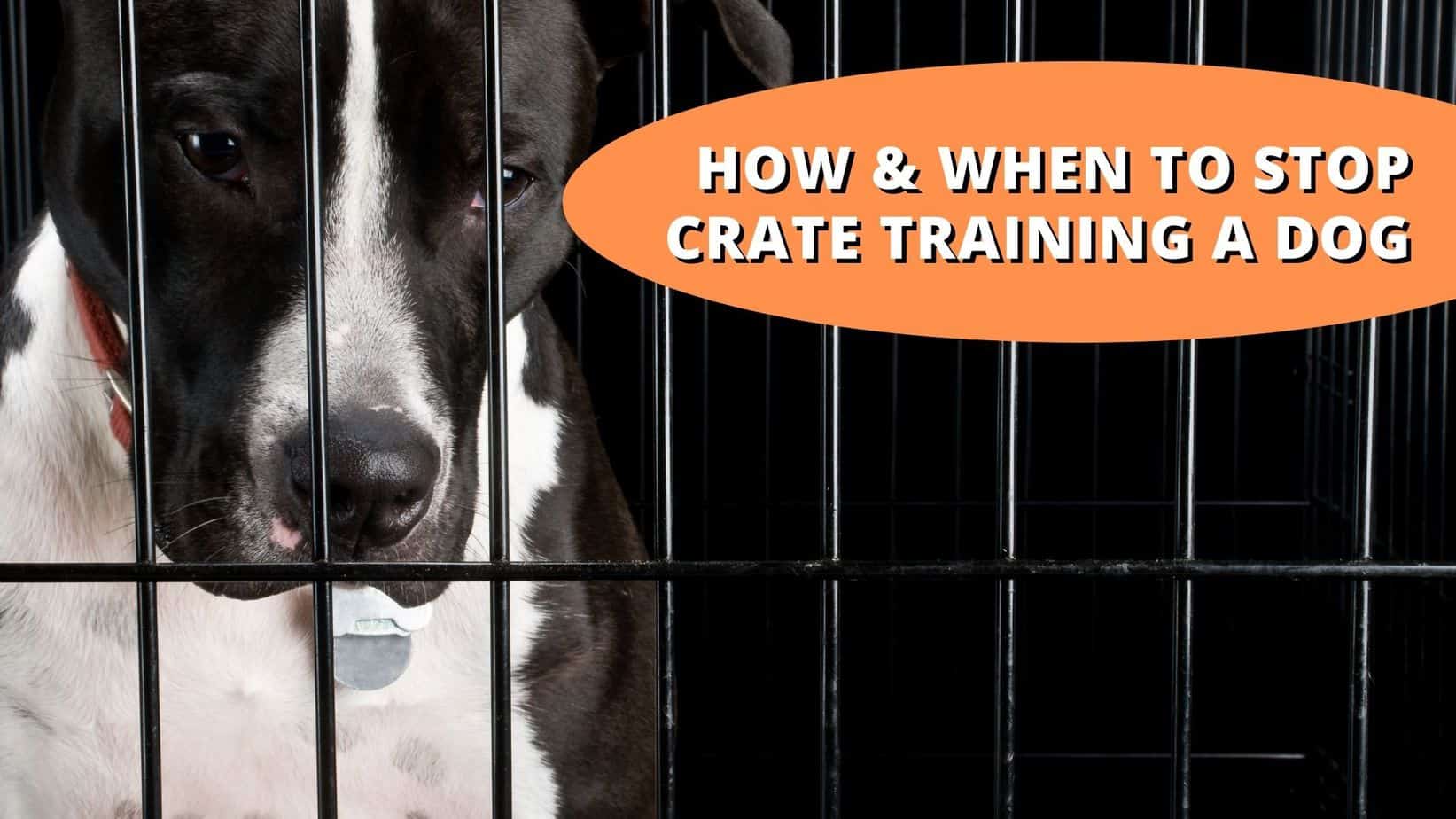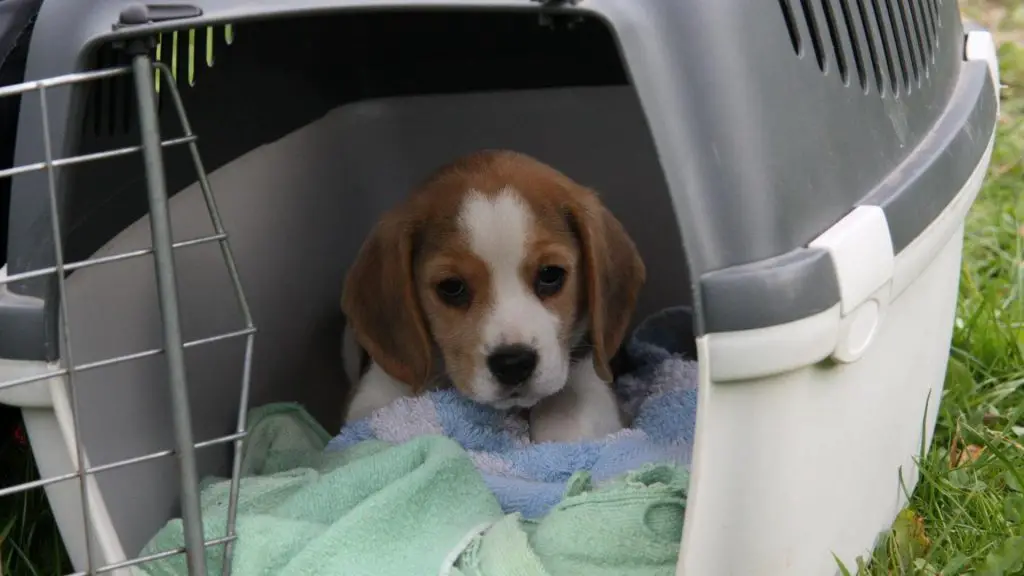Pawscessories is reader-supported. When you buy via links on our site, we may earn an affiliate commission at no cost to you.
Learn more.
Crate training is overall a great way to train your dog, but it’s not the only option. It can also be used for house-training purposes, or as a safe place when you’re out of the house.
Some dogs take to crate training more naturally than others – and some may require additional methods like confinement in an area with less distractions.
A question that many crate trainers wonder is, when is it okay to stop crate training a dog?
Many people find success in using crates to teach their dogs a variety of great habits. Including, but not limited to, learning how to use the bathroom outdoors and recognizing healthy boundaries.
However, there may come a time when you need to stop using the crate for one reason or another. In this post we’ll go over how to know when it’s time to discontinue your wonderful crate training.
Table of Contents

Many people don’t realize that crate training is simply a learning tool. Your pet may grow out of the need to be crated as they’ve mastered what you’re trying to teach them.
Understanding when it’s appropriate to release your dog from their crate training will vary based on the type of situation you’re in and how your dog is progressing.
At What Age Can You Stop Crate Training?
So, when is it okay to stop crate training a dog? At what age can you stop crate training? If your dog outgrows their need for a crate, you might need to re-evaluate your strategy on using said crate.
There is no specific age for a dog where its okay to stop crate training. Every dog is different. When your dog becomes well behaved, then you can start testing the waters without a crate.
You’ll know when your dog is ready to be out of the crate when they no longer need it for security, or to stop them from misbehaving.
This is especially true for puppies, who can get into trouble—or even hurt themselves—when left to their own devices.
If housetraining is your primary reason for using a crate, be sure to set a goal of two months from the last accident. This mess-free timespan should help you determine whether or not it’s time to explore phasing out the crate.
Dogs are well adapted to a quiet and serene environment. If your dog starts staying in their crate when they need some peace and quiet you don’t have to enforce crating quite as much.
As you likely remember from learning to crate train your pup… The most important strategy to make their crate a positive space for them to go.
Already noticing this is a tendency of theirs? You can explore partially opening the door so that they have greater freedom to come and go as they please.
When Should You Stop Using a Dog Crate?

If you’re wondering when to stop using a dog crate, it’s important to note that there is no one-size-fits-all answer. The decision of whether or not to keep your dog in a crate should be based on your individual pet’s needs.
Some dogs may need their crates, while others may only need it for a few months. It all depends on the dog’s personality and behavior.
If your dog is crate trained and you find benefits to using it, there is no need to stop using it. However, if you feel there is no longer a need for the crate, then you can start phasing it out.
Here are a few signs that may indicate your dog no longer needs their crate:
- They’re no longer afraid of being in the crate
- They don’t cry or whine when you put them in the crate
- They don’t try to escape the crate
- They no longer have accidents in the crate
- You no longer need to use the crate to prevent them from destroying your home
When To Stop Using Crate At Night?

If you’re wondering when to stop using a crate at night, the answer is pretty much the same as above.
It depends on your individual pet’s needs. If they’re still afraid of the crate or you feel they need it for security, then there is no need to stop using it.
However, if they get into trouble at night without their crate, then it’s probably not a good idea.
Here are a few signs that may indicate your dog no longer needs their crate at night:
- They sleep through the night without crying or whining
- They don’t have accidents in the crate at night
- They wont destroy your house at night outside of the crate
How Do I Stop Crating My Dog Successfully?

STEP 1: Gradually Transition Away
If you want to transition away from a crate, it’s best to do so gradually.
The last thing you want to do after all of your training efforts is set your dog up to fail.
This will take a bit more time and effort before crate training can be finalized and completely stopped.
You can start out by keeping your pup out of their crate during certain parts of the day. This will allow them to increase their exposure outside of the crate.
You should always make sure your dog has a chance to use the restroom before these outings.
It’s important to not feed them a large meal or offer a large drink of water before they’re set loose.
This will help discourage an accident from happening in your home.
STEP 2: Advised Supervision
This new routine is going to require more supervision around the house at first, so be sure to do this when you have time and you’re also spending extra close attention on them.
It’s important to get your dog used to longer periods of time out of the crate. This way they won’t have any accidents when you leave them for longer time spans like while you’re at work.
STEP 3 (Optional): Limited Access
A good idea instead of restricting their access to your entire home (crating), confine them in a large, contained area and provide easy access for activities.
Eventually, your dog should graduate to your main living space and make the rest of your shared home easier for everyone.
Giving them their favorite toy, or treating them to something frozen that takes a while to eat will help keep your pup focused on one thing.
This can help prevent destructiveness which might cause relapses in bathroom-break rules at home.
Your dog is now equipped to stop crate training!
Why You Might Want To Continue Crate Training

There are many reasons why people want to crate train their dog. Any of them can have successful results when done right.
Crates provide a sense of safety for your pup. Limited/enclosed spaces mimic the feeling of a den which is naturally desired by most dogs.
A dog crate can also serve as a quiet, peaceful sanctuary. This can come in handy when you share your home with visitors or have children who are up and about throughout the day.
Some dog parents find their pets eager to go into crates for a private sense of “me-time” when they’re feeling stressed, overwhelmed, or simply haven’t had enough rest.
Crate training your dog can be a good option for people with young puppies. Most commonly used to help acclimate their new furry family to their home.
What makes crate training so effective when training a new dog is that the same den-like dwelling helps make them feel safe in their crates.
As they begin to realize this den-like crate is their own space it makes them much less likely to soil where they rest.
So, instead of giving your dog anywhere access to the house. Set up a potty break routine where they can go number 1 & 2 before you leave them.
Making sure to do this makes it easier for them not to have any accidents while you’re gone.
Related Reading: What’s the Purpose of Crate Training Your Dog?
Final Thoughts
Training a pupster is never easy. Many dog owners have found that crates can be a helpful tool when addressing certain behaviors.
Some people have had success with using a crate training method to enforce certain rules— for example, when you’re trying to prevent destructive behavior.
If you have a dog that has behavioral issues, such as aggression toward other animals and people, your training should be ongoing.
We wouldn’t advise stopping using the crate just because they’ve gotten better on day-to-day management of their behavior.
Furthermore, some people like to keep their dog confined in a crate when they travel frequently or if trips to the vet are a frequent occurrence.
The idea of not seeing your pet destroying your belongings and urinating on your carpets is certainly an appealing one. But, adapting to new routines each time can lead to frustration for your pet.
Leaving a dog in their crate for extended periods of time is, of course, never okay. A crate should not be used to keep your dog cooped up for over 8 hours.
However, using the crate as a tool to teach your pup some boundaries or help them calm down from a session of playing is not the same thing and totally acceptable.
So, when is it okay to stop crate training a dog? It certainly depends on a case-by-case situation.
If you feel your dogs time is now, we hope our simple steps help you guide to dog to life after crate training.
If your doggo is happy in a crate, feels secure and can’t be left without one for practical reasons, it’s totally okay to keep them there until better circumstances arise.
Other posts you might find interesting:
Is Crate Training Bad For Dogs | The Truth
